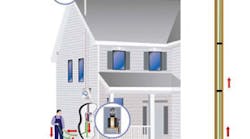The Shocking Truth About Grounding Electrode Conductors
Have you done any service work lately, and noticed a spark as you connect or reconnect the grounding electrode conductor to the ground rod of what appeared to be a perfectly normal electric service? Have you ever disconnected the grounding electrode conductor at a water pipe and received a shock? Have you ever noticed any arcing or sparking at a loose grounding electrode conductor at an outbuilding that has a connection to its own separate ground rod? If you answered “yes” to any of these questions, the culprit is more than likely currents in the grounding electrode conductor.
Although electricians often attribute these phenomena to “phantom” currents or some sort of mysterious phase imbalance, the condition is usually due to a much different source. Many times, grounding electrode conductors regularly carry current. Many electricians assume the only time there will be current in a grounding electrode conductor for a properly wired system is during a fault. This assumption is usually based on the definitions presented in Art. 250 of the NEC, specifically the interpretations and misinterpretations of 250.2.
The requirements of 250.2 tell us that an effective ground fault current path is, “An intentionally constructed, permanent, low-impedance electrically conductive path designed and intended to carry current under ground fault conditions from the point of a ground fault on a wiring system to the electrical supply source and that facilitates the operation of the overcurrent protective device or ground fault detectors on high-impedance grounded systems.”
Although this section of the Code clearly describes the function of proper bonding, particularly for low-voltage systems, use of the word “ground” in the definition sometimes gives the impression that the grounding electrode conductor is part of the fault-clearing path, and that the currents are only temporary, lasting only until an overcurrent protective device opens the circuit. With that assumption, and based on that incorrect interpretation, many electricians assume that in a properly functioning electrical system, currents in grounding electrode conductors are only present during faults — and only for a very short time. Although further examination of 250.4(A)(5) should make it clear that the earth shall not be considered an effective ground-fault current path, misconceptions persist.
The case of the open neutral. In a properly functioning electrical system, the neutral conductor carries the imbalance current of the system. For a single-phase system, the imbalance is the difference between the currents in the two “hot” legs of the transformer. For a 3-phase system, the neutral current is the imbalance between all three hot phases. To further clarify this point, let's review an example, starting with the review of a single-phase 120/240V system.
The current imbalance needs to return via the neutral conductor back to the transformer. But, if that neutral is open, the imbalance current will seek other paths to get back to the neutral leg of the transformer. At the main service, the neutral and ground are connected via the main bonding jumper. If the ground path has a low enough resistance, it may prove to be a satisfactory return path, and the imbalance current will travel through the main bonding jumper into the grounding electrode. Since the transformer neutral is grounded by the utility, and since the main bonding jumper connects the neutral and grounding conductor at the service, as per NEC requirements, the ground path provides a complete return for the imbalance current.
Many times, the first clue to finding an open neutral in your system is to measure a potential difference at the various loads in a building. With the absence of a neutral conductor (or a high-resistance return path), there is no path for the imbalance current to return back to the source. When the neutral is open, and there is no return path at all, the entire system becomes a 240V series system. In the case of an open neutral, when the ground path is of high resistance, the open neutral becomes evident as the voltage difference between the phases. In the case of an open neutral with a low-resistance ground path, the open neutral may never be detected. Currents may continue to travel this path for years until an unsuspecting person opens the ground circuit, potentially placing them in harm's way.
Typically during a service upgrade project, you're likely to disconnect the old grounding electrode conductor and replace it with a new conductor properly sized for the upgraded service and the new service ampacity requirements. You may also find yourself disconnecting a grounding electrode conductor during routine repair work or electrical system maintenance. It's at this point in the work process that you can expose yourself to a dangerous or potentially fatal shock (Fig. 1 on page C14).
The path of least resistance. All of us in the electrical industry have been conditioned with the phrase “current travels through the path of least resistance.” But is this really true? Some people conclude that when there are multiple paths for current to flow, current only flows through the path of least resistance. However, a more accurate description of current flow back to the source is that the majority of current flows through the path of least resistance, and less current flows through paths of higher resistance (Fig. 2 on page C16). Given multiple paths back to the source, current will flow through all paths to reach its destination, with the majority of current flowing through the path of least resistance.
Almost every electrical system has multiple grounding electrodes; ground rods, water pipes, building steel, etc., with a grounding electrode conductor to each. A service with multiple grounding electrode conductors that has a higher resistance on one of the conductors, and little or no measurable current in it, may still have significant current in the other grounding electrode conductors. Therefore, measuring the current in the conductor going to the ground rod and proving it safe does not mean there is a safe current level in the conductor going to the water pipe.
Your neighbor's problem is now your problem. Let's take a look at another example. This time you're working in a building or a house, and you're sure there is a continuous neutral. You look at the service entrance conductors, and don't see any breaks. Everything appears to be in good condition, including the neutral conductor and all neutral connections. You are convinced that since there have been no complaints about fluctuating voltages, or any other indications of an open neutral, that a neutral problem at this building doesn't exist. You even go as far as measuring current in the neutral, and convince yourself that since there is current in the neutral conductor, there can't be an open neutral. This leads you to have no fear of opening up any grounding electrode conductors. Is this a safe assumption?
Even though the building you're working on may have a completely continuous neutral back to the transformer, the house next door or a building somewhere in the general vicinity may have an open neutral. If the building you're working in and the building with an open neutral have some type of conductive path between them, current may return via that path. A metal water pipe is a good example of such a connection. Current can come “up” through a ground rod or a water pipe into the building you're working on, due to an open neutral in a neighboring building. Figure 3 on page C16 illustrates this condition. The metal water pipe common to the buildings has such a low resistance, that it may not be apparent at the building with the open neutral that there is a problem. The current exits the building with the open neutral through the metallic pipes and finds its way back up through the grounding electrode conductors in your building. Any grounded electrically conductive path between buildings can serve as a return path for current for a building with an open neutral.
The grounded coaxial braid in the jacket of cable television drops can also serve as return paths for the neutral imbalance current from a building with an open neutral (Fig. 4). Cable television systems should be grounded as they enter the premises as per Art. 680 of the NEC. Since the cable television connection blocks typically get grounded directly to the same grounding electrodes that the electric service uses (or they have their own separate grounding electrode, and that electrode gets bonded to the electrical system grounding electrode), this can become a return path. However, this situation is quite rare, since the ampacity of the return current tends to burn out the coaxial cable). Nonetheless, it can still exist and create a hazard.
Is the current coming or going? So now you're convinced that there can be current flowing in a grounding electrode conductor. Next time you're on-the-job, use your ammeter to measure the current in the grounding electric conductor before you open up that connection. If you measure a current, how do you know if it's due to current going “down” into the ground at this building or current coming up through the grounding electrode conductor in your building and returning back to the source via your neutral?
Unfortunately, putting an ammeter on the conductor will only prove that there is current flowing in the conductor. It does not tell you the direction of that current. You must use Kirchoff's Law to determine the direction of the current flow. Kirchoff's Law states that all currents entering a connection are equal to the currents leaving a connection. Simply put, all currents must balance. Let's look at a couple of examples for clarification.
Example No. 1. You're working on a single-phase, 120/240V service. You measure 11A in the black conductor at the main service panel. You measure 5A in the red conductor at the main service panel. On a single-phase service, the neutral current is the difference between the two legs of the transformer, which in this case is 6A. Therefore, if you measure 6A in the grounding electrode conductor and 0A in the neutral service entrance conductor, you can be relatively certain that the neutral is open, and your building is dumping current into an alternate return path (i.e. the grounding electrode).
Example No. 2. You're working on a single-phase, 120/240V service. You measure 11A in the black conductor at the main service panel. You measure 5A in the red conductor at the main service panel. As in the first example, the neutral current will be the difference between the two legs of the transformer, which is 6A. However, this time you measure 8A in the grounding electrode conductor. How can this be? Can there possibly be more current being dumped into the ground by the system you're working on than the system imbalance current? Are there 2A of extra phantom current? When you measure the current in the neutral, you find 14A. Now you're really confused. Applying Kirchoff's Law to the circuit, you quickly realize that the 6A of current imbalance from the system you're working on is being joined with 8A coming into this system from somewhere else.
Final thoughts. Neutral current will return to its source via any means possible. That return path could be through a conductor or connection that may seem unlikely to you, such as a grounding electrode conductor.
As electrical services in some neighborhoods around the country age — and the likelihood of an open neutral is more probable as well as in areas with high population density where at least one open neutral may exist — neutral currents seeking return paths through what may be considered unconventional means become more likely. In any and all cases, shock hazards can exist with all electrical conductors, including grounding electrode conductors.
Osoliniec is a private consulting engineer located in Warren, N.J. He is a licensed professional engineer and electrical contractor in the state of New Jersey.
Things to Consider
-
Never assume that a grounding electrode conductor is “dead,” or you may be.
-
If there is no current in one of the grounding electrode conductors, this doesn't mean there is no grounding electrode current flowing somewhere in the system. Treat all grounding electrode connection points individually.
-
Always assume the grounding electrode conductor is “hot,” and treat it as such, until proven otherwise.
-
Even though the system you're working on may be functioning correctly, and have a good neutral, a dangerous condition may still exist if there is an open neutral in a neighboring building.
-
Even if the main circuit breaker in the building you're working in is open, as long as the neutral provides a path for that imbalanced current, current can be flowing up through your grounding electrodes, and back through your neutral.
-
Current can come into the system you're working on from a local faulty system.
-
The neutral in the building you're working on was sized for its own service, not for additional current from another service. If a neighboring building has an open or faulty neutral, it may affect the system you're working on.



